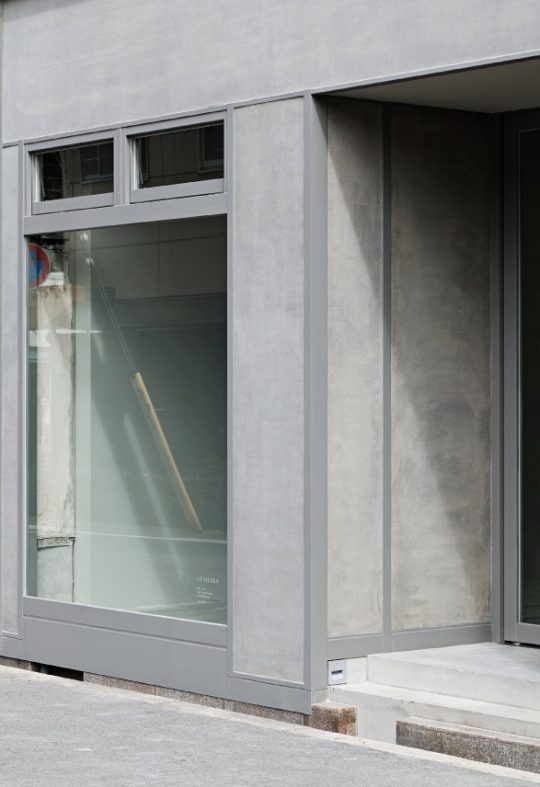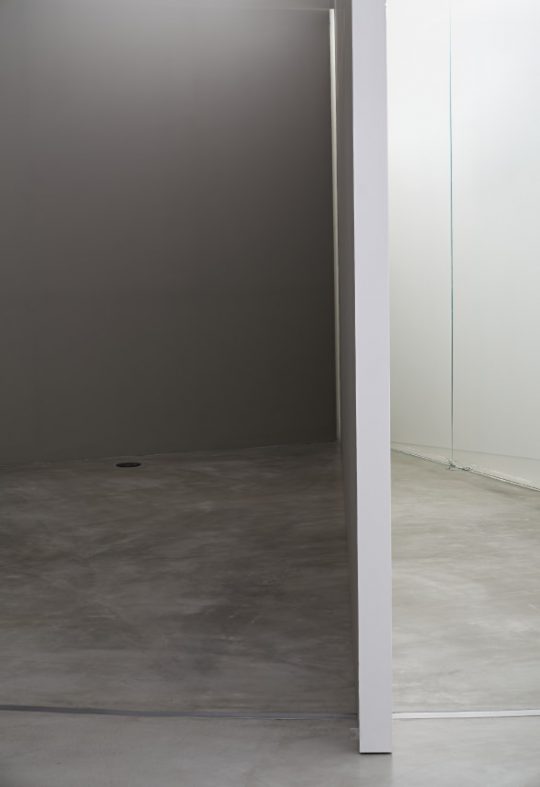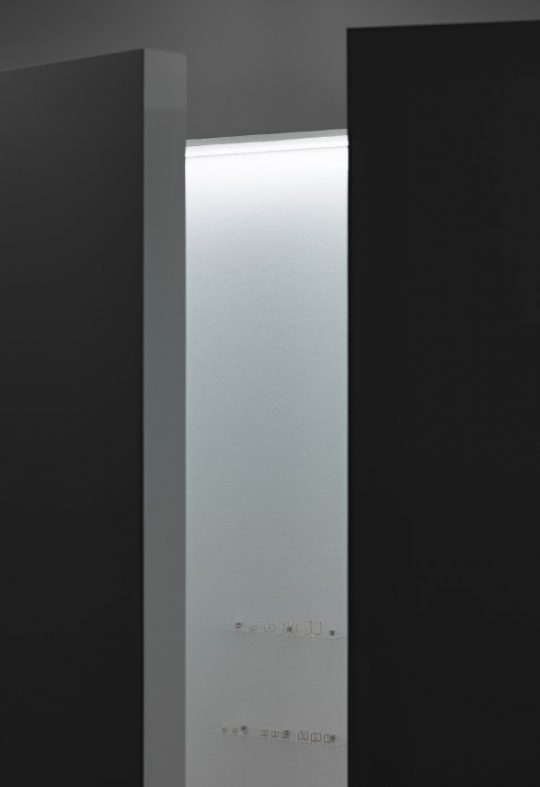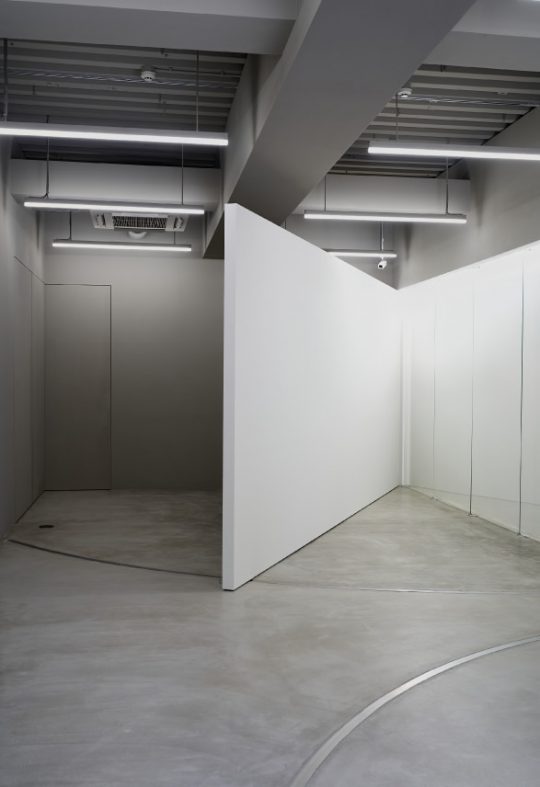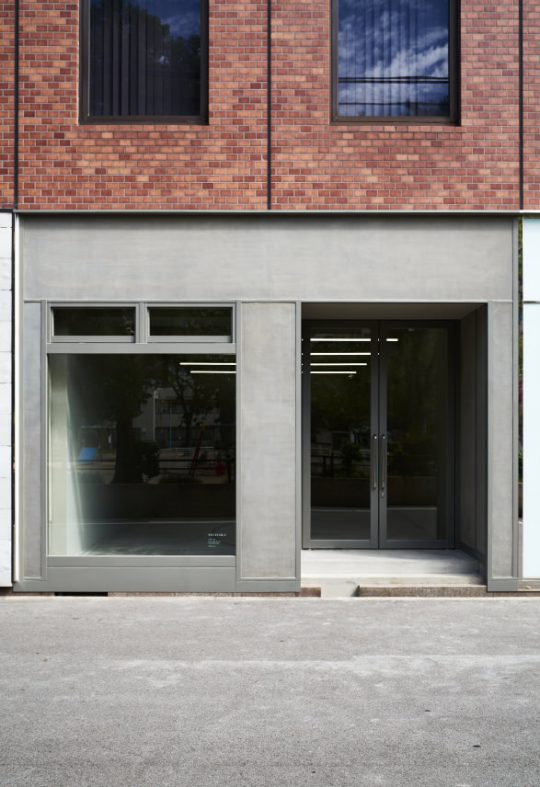
11 27 2020
Osaka
Masahiro Harada + MAO
大阪の南堀江・堀江公園沿いに、
まるで入居者を募集しているかのような“空っぽ”のお店がある。
2019年秋にオープンした大阪店。
無機質な空間の中には、壁のような可動式の扉が埋め込まれていて、
それを開くとジュエリーが現れる。
「実はインテリア苦手なんです。
出来て死ぬまでがすごく短命だから」と話すのは、
MOUNT FUJI ARCHITECTS STUDIOの原田真宏さん。
彼こそ、パートナーの原田麻魚さんと一緒に神宮前にある
SHIHARA LABとSHIHARA OSAKAを手がけた建築家である。
代々木にある彼らの事務所で少しの間雑談をした。
「2014年にオープンしたSHIHARA LABの内装建築の依頼を受けた時、
実物のジュエリーを手にしたり、
“いわゆる一般的なジュエリーのような様式的な装飾は一切排して、
極めて抽象度の高い幾何形態のようなもの求めている。
これと生身の身体が関係することでデザインが生まれる”
というような話を聞いてみると、何か面白いことができそうだなと思ったんです。
いわゆるプラトン立体のような、太古から人間が思い浮かべていた抽象的な形。
しかし、それがその形を作りたいというだけでなく、
その形そのものを生かしてファンクションを作ろうとする
SHIHARAのアプローチと私たちの建築の自然科学的な方法論が
重なるように思えたんです。
下地上への塗装や貼り物のことを建築では“化粧”と呼ぶのですが、
既製の様式や仕上げという“化粧”の多くが、長い時間を経ていく過程で
結局価値を失っていくのを何度も僕は目の当たりにしてきました。
けれども、その様式や化粧のない初源的なものは、
古代ギリシャのプラトンの時代にあるわけです。
だからSHIHARA OSAKAでは様式を無理矢理に導入しようとはせず、
あえて様式を持っていないようなものを蓄積していく。
蓄積することである一つの様式を生みだすような空間にしたいと思った時に、
これは短命なことしているわけではないと、納得できたんです。
デザインというのは基本的に「図」を作る仕事だと僕は思っています。
いかに目を引く「図」を作るのか。
でも実はそれと同じくらいか、もっと大事なことが、
「地」を正確に把握できるか、
デザインする「地」がこうだからこのような設計にしようと
セットで考えていくことなんです。
なので、僕らもあれこれ手を動かす前に
まずは「地」の部分を知ることが大切なんですね。
大阪はものすごく「図」であふれている場所です。
みんな言いたいことがありすぎてすごい押し出しが強い世界。
さまざまな意図があふれている世界の中、
SHIHARA OSAKAはあえて意図がない状態にできないかと思いました。
つまりそれはデザインをしないということ。
ミニマルとはまた異なる、ものすごく吟味された中での意図がない状態です。
このお店の前を通った人は「新しいお店ができたんだ」とは思わず、
工事現場か、テナントが入る前のラフな状態ぐらいとしか
思わないかもしれません。
だけども扉が開いていき、
透過ガラスと純度の高い白の世界がちょっとずつ現れてくると
ジュエリーショップと初めて理解する。
例えるならば、SHIHARA OSAKAは、ものすごくうるさい人たちの中で、
全く話さない人がいる感じに近いかもしれません。
そんな人が妙に気になったりすることありますよね?
おそらくこれからも街にはさまざまな様式が入り変化していくと思います。
そんな中でSHIHARA OSAKAは永遠不変のエンプティー、
意図がないタイムレスな場所になればいいなと思ったんです」
大阪の堀江という場所は、江戸時代は遊郭として栄え、
また戦後は家具屋通りとして栄え、
さらに現在はオレンジストリートを中心に
さまざまなアパレルのセレクトショップがずらりと並んでいる。
若者たちで賑わうオレンジストリートから
一本道を挟んだ場所にあるSHIHARA OSAKA。
向かいには堀江公園があり、そこでは子供たちが遊びにきたり、
ビジネスマンがテイクアウトしてきたランチを気持ち良さそうに食べている。
戦後の復興に伴い地域住民と大阪市との協力で作られたこの堀江公園。
昔、近所に住む子供たちや、家具の職人さんたちがきっと
今のように公園内を駆け回ったり、休憩していたのかもしれない。
この景色もずっと変わらないのだろう。
大阪の南堀江・堀江公園沿いに、
まるで入居者を募集しているかのような
“空っぽ”のお店がある。
2019年秋にオープンした大阪店。無機質な空間の中には、
壁のような可動式の扉が埋め込まれていて、
それを開くとジュエリーが現れる。
「実はインテリア苦手なんです。
出来て死ぬまでがすごく短命だから」と話すのは、
MOUNT FUJI ARCHITECTS STUDIOの原田真宏さん。
彼こそ、パートナーの原田麻魚さんと
一緒に神宮前にあるSHIHARA LABと
SHIHARA OSAKAを手がけた建築家である。
代々木にある彼らの事務所で少しの間雑談をした。
「2014年にオープンしたSHIHARA LABの
内装建築の依頼を受けた時、
実物のジュエリーを手にしたり、
“いわゆる一般的なジュエリーのような
様式的な装飾は一切排して、
極めて抽象度の高い幾何形態のようなもの求めている。
これと生身の身体が関係することで
デザインが生まれる”
というような話を聞いてみると、
何か面白いことができそうだなと思ったんです。
いわゆるプラトン立体のような、
太古から人間が思い浮かべていた抽象的な形。
しかし、それがその形を作りたいというだけでなく、
その形そのものを生かして
ファンクションを作ろうとする
SHIHARAのアプローチと
私たちの建築の自然科学的な方法論が
重なるように思えたんです。
下地上への塗装や貼り物のことを
建築では“化粧”と呼ぶのですが、
既製の様式や仕上げという“化粧”の多くが、
長い時間を経ていく過程で
結局価値を失っていくのを
何度も僕は目の当たりにしてきました。
けれども、その様式や化粧のない初源的なものは、
古代ギリシャのプラトンの時代にあるわけです。
だからSHIHARA OSAKAでは
様式を無理矢理に導入しようとはせず、
あえて様式を持っていないようなものを蓄積していく。
蓄積することである一つの様式を
生みだすような空間にしたいと思った時に、
これは短命なことしているわけではないと、
納得できたんです。
デザインというのは基本的に「図」を作る仕事だと
僕は思っています。いかに目を引く「図」を作るのか。
でも実はそれと同じくらいか、もっと大事なことが、
「地」を正確に把握できるか、
デザインする「地」がこうだからこのような
設計にしようとセットで考えていくことなんです。
なので、僕らもあれこれ手を動かす前に
まずは「地」の部分を知ることが大切なんですね。
大阪はものすごく「図」であふれている場所です。
みんな言いたいことがありすぎて
すごい押し出しが強い世界。
さまざまな意図があふれている世界の中、
SHIHARA OSAKAはあえて意図がない
状態にできないかと思いました。
つまりそれはデザインをしないということ。
ミニマルとはまた異なる、
ものすごく吟味された中での意図がない状態です。
このお店の前を通った人は
「新しいお店ができたんだ」とは思わず、
工事現場か、テナントが入る前のラフな状態ぐらいとしか
思わないかもしれません。
だけども扉が開いていき、
透過ガラスと純度の高い白の世界が
ちょっとずつ現れてくると
ジュエリーショップと初めて理解する。
例えるならば、SHIHARA OSAKAは、
ものすごくうるさい人たちの中で、
全く話さない人がいる感じに近いかもしれません。
そんな人が妙に気になったりすることありますよね?
おそらくこれからも街にはさまざまな様式が入り
変化していくと思います。
そんな中でSHIHARA OSAKAは永遠不変のエンプティー、
意図がないタイムレスな場所になればいいなと
思ったんです」
大阪の堀江という場所は、江戸時代は遊郭として栄え、
また戦後は家具屋通りとして栄え、
さらに現在はオレンジストリートを中心に
さまざまなアパレルのセレクトショップが
ずらりと並んでいる。
若者たちで賑わうオレンジストリートから
一本道を挟んだ場所にあるSHIHARA OSAKA。
向かいには堀江公園があり、
そこでは子供たちが遊びにきたり、
ビジネスマンがテイクアウトしてきたランチを
気持ち良さそうに食べている。
戦後の復興に伴い地域住民と
大阪市との協力で作られたこの堀江公園。
昔、近所に住む子供たちや、家具の職人さんたちがきっと
今のように公園内を駆け回ったり、
休憩していたのかもしれない。
この景色もずっと変わらないのだろう。
Across from Horie Park in Minamihorie, Osaka, there is a retail store that initially appears to be vacant. In actuality, it’s Shihara’s Osaka store that opened in the fall of 2019. Once the largescale doors built into the wall of the stark space opens up to reveal a wall full of jewelry, it reveals itself to be a jewelry store.
“Interior design isn’t my expertise — their lifespans are so much shorter compared to architecture,” says Masahiro Harada from Mount Fuji Architects Studio, the architect responsible for designing both of Shihara’s stores along with his partner Mao Harada, as we chatted with him at his studio in Yoyogi. “When we were first asked to design Shihara Lab that opened in Tokyo in 2014, we had a chance to see the jewelry in person for the first time and was explained that they were designed from a theoretical standpoint while updating the conventional rules, functions and structures of jewelry to a more clean, streamlined design. This made me realize that we were onto something very thought-provoking. The fact that he used platonic solids such as tetrahedrons and cubes in his jewelry not merely as a design motif but with a functional purpose resonated with how we see architecture. In many instances over the years, I’d seen interior finishes deteriorate as time passed, resulting in spaces with lessened commercial value. For the interior of Shihara Osaka, we focused on layering non-decorative materiality, similarly to how the jewelry is designed while considering the fact that platonic solids derived from ancient Greece, where so-called finishes didn’t yet exist. By adding a bare minimum amount of materials on top of each other for the sole purpose of its functionality, I’d come to realize that we weren’t creating just another short-lived interior space, but one that lasts and ages well. I think design is all about creating the most eye-catching figures. The even more important aspect is to know the context of a space and to keep it in mind before inserting any figures at all. Osaka is a city filled with figures — everything and everyone has something to say. With so much going on, we chose to go the opposite by being unintentional and essentially created a non-designed space. I consider this to be nuanced differently from minimalism, and rather a state of unintentional scrutiny. Passerbys may think that there’s a construction site or an exposed concrete space waiting to be rented, but when the large doors open up and the clear glass and white wall filled with jewelry appear from within, it reveals itself to be the jewelry store that it is. I think the store could be compared to the one quiet person in a room full of loud people — he’s oddly conspicuous and compelling. Osaka may continue to evolve, while Shihara Osaka will stand still in its timelessness as an eternal empty space.”
During the Edo period, the Horie district was once the red-light district. Postwar, it developed into an area known for furniture stores. It has now grown into what has become one of the most fashionable streets filled with small brands and boutiques alike. One street away from the fashionable Orange Street is Horie Park, where children play while suited businessmen devour their lunch. The park was built as part of the postwar reconstruction in collaborative efforts of the city and the people. We like to imagine the local children and cabinetmakers occupying the park when it first opened back in the day. As the city evolves, we hope the park remains an oasis within the chaos as Shihara Osaka quietly but conspicuously exists within its premises.
Across from Horie Park in Minamihorie, Osaka, there is a retail store that initially appears to be vacant. In actuality, it’s Shihara’s Osaka store that opened in the fall of 2019. Once the largescale doors built into the wall of the stark space opens up to reveal a wall full of jewelry, it reveals itself to be a jewelry store.
“Interior design isn’t my expertise — their lifespans are so much shorter compared to architecture,” says Masahiro Harada from Mount Fuji Architects Studio, the architect responsible for designing both of Shihara’s stores along with his partner Mao Harada, as we chatted with him at his studio in Yoyogi. “When we were first asked to design Shihara Lab that opened in Tokyo in 2014, we had a chance to see the jewelry in person for the first time and was explained that they were designed from a theoretical standpoint while updating the conventional rules, functions and structures of jewelry to a more clean, streamlined design. This made me realize that we were onto something very thought-provoking. The fact that he used platonic solids such as tetrahedrons and cubes in his jewelry not merely as a design motif but with a functional purpose resonated with how we see architecture. In many instances over the years, I’d seen interior finishes deteriorate as time passed, resulting in spaces with lessened commercial value. For the interior of Shihara Osaka, we focused on layering non-decorative materiality, similarly to how the jewelry is designed while considering the fact that platonic solids derived from ancient Greece, where so-called finishes didn’t yet exist. By adding a bare minimum amount of materials on top of each other for the sole purpose of its functionality, I’d come to realize that we weren’t creating just another short-lived interior space, but one that lasts and ages well. I think design is all about creating the most eye-catching figures. The even more important aspect is to know the context of a space and to keep it in mind before inserting any figures at all. Osaka is a city filled with figures — everything and everyone has something to say. With so much going on, we chose to go the opposite by being unintentional and essentially created a non-designed space. I consider this to be nuanced differently from minimalism, and rather a state of unintentional scrutiny. Passerbys may think that there’s a construction site or an exposed concrete space waiting to be rented, but when the large doors open up and the clear glass and white wall filled with jewelry appear from within, it reveals itself to be the jewelry store that it is. I think the store could be compared to the one quiet person in a room full of loud people — he’s oddly conspicuous and compelling. Osaka may continue to evolve, while Shihara Osaka will stand still in its timelessness as an eternal empty space.”
During the Edo period, the Horie district was once the red-light district. Postwar, it developed into an area known for furniture stores. It has now grown into what has become one of the most fashionable streets filled with small brands and boutiques alike. One street away from the fashionable Orange Street is Horie Park, where children play while suited businessmen devour their lunch. The park was built as part of the postwar reconstruction in collaborative efforts of the city and the people. We like to imagine the local children and cabinetmakers occupying the park when it first opened back in the day. As the city evolves, we hope the park remains an oasis within the chaos as Shihara Osaka quietly but conspicuously exists within its premises.
SHIHARA OSAKA
大阪府大阪市西区南堀江1-12-19
06-4394-8048
SHIHARA OSAKA
1-12-19 Minamihorie, Nishi-ku, Osaka
06-4394-8048




